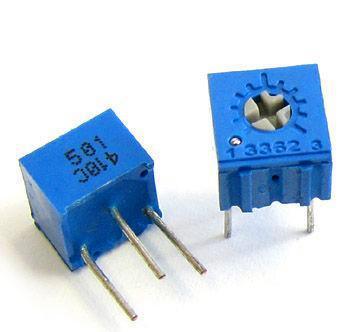Adjustable resistor is an electronic component that is very common in instrumentation, security equipment, and home appliance control boards. The adaptation of adjustable resistor is mainly considered from the perspective of the voltage dividers. The resistance value R on both sides of the resistor can be relatively accurate and stable. , The power of the adjustable resistor is small, and the absolute accuracy can be ignored, which is mainly considered from the current controller. The following lists the matters needing attention in the use of adjustable resistors:
1. The power of the adjustable resistor can withstand the ambient temperature of 70 degrees Celsius, and other functions may be lost when the operating temperature is higher than 70 degrees Celsius.
2. The surface of the adjustable resistor should avoid the presence of water droplets and avoid using it in a humid place.
3. The rotating operating force of the adjustable resistor will become lighter as the temperature rises, and tighten as the temperature decreases. If the potentiometer is used in a low-temperature environment, it needs to be explained in order to use special low-temperature resistant grease.
4. When installing the rotary adjustable resistor, the strength should not be too tight when fixing the nut to avoid damage to the thread or poor rotation.
5. When installing the adjustable resistor in the iron case, do not use too long screws, otherwise it may hinder the movement of the sliding handle and even directly damage the potentiometer itself.
6. Adjustable resistors are best used in voltage adjustment structures, and current adjustment structures should be avoided, because the contact resistance between the resistor and the contact piece is not conducive to the passage of large currents.
7. When the adjustable resistance is welding, if the welding temperature is too high or the time is too long, it may cause damage to the potentiometer.
8. The terminal of the plug-in adjustable resistance should be welded at 235℃±5℃. Finished within three seconds, the soldering should be more than 1.5mm away from the potentiometer body, do not use solder to flow through the circuit board during soldering.
9. The shaft or sliding handle of adjustable resistance should be as short as possible when designing. The shorter the shaft or sliding handle, the better and stable the hand feel. On the contrary, the longer the shaking, the greater the shaking, and the feel is easy to change.
10. The shaft or sliding handle of adjustable resistance should be as short as possible when designing it. The shorter the shaft or sliding handle, the better and stable the hand feel. On the contrary, the longer the shaking, the greater the shaking, and the feel is easy to change.
11. When soldering the terminals of adjustable resistors, avoid using water-soluble flux, otherwise it will promote metal oxidation and material mold.
12. Avoid using inferior flux during use. Poor soldering may cause difficulty in soldering, resulting in poor contact or open circuit.
